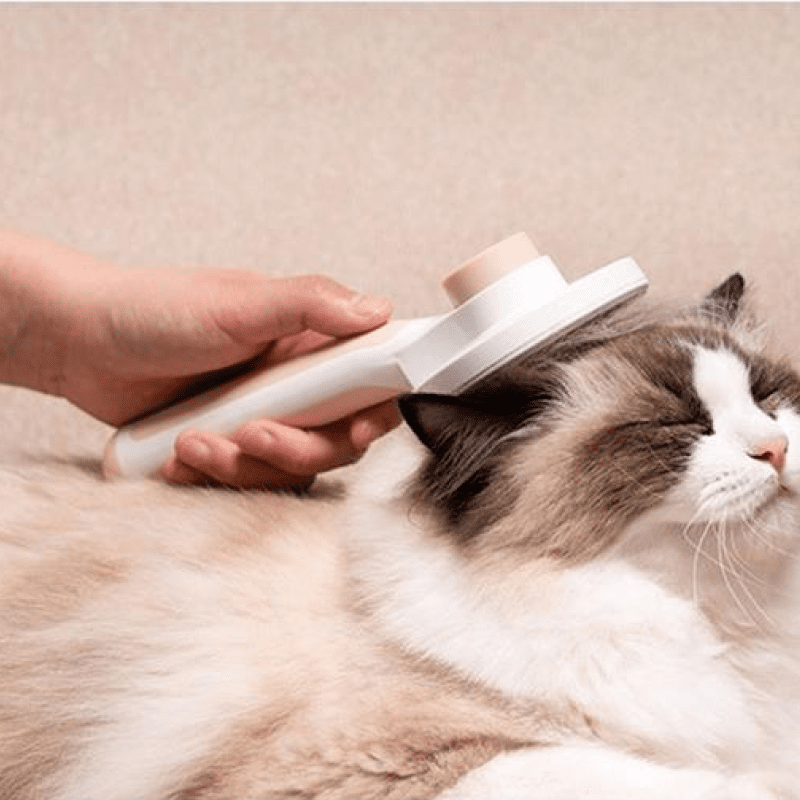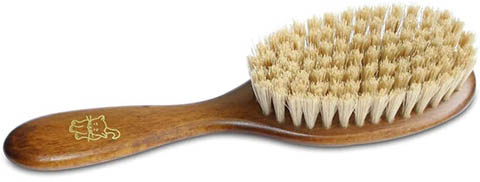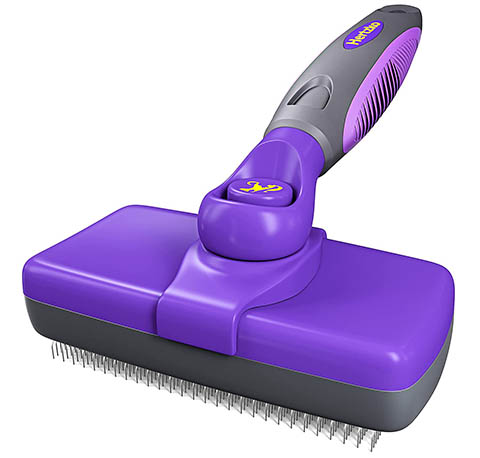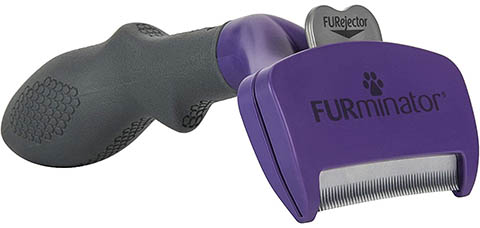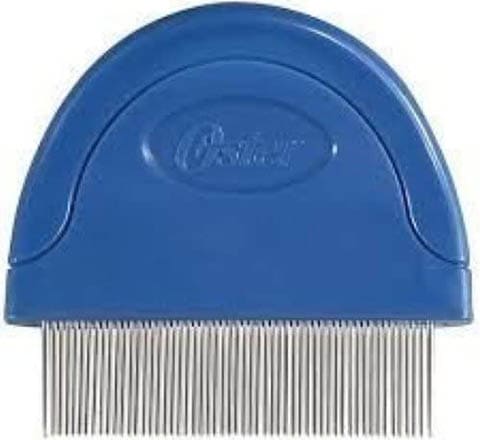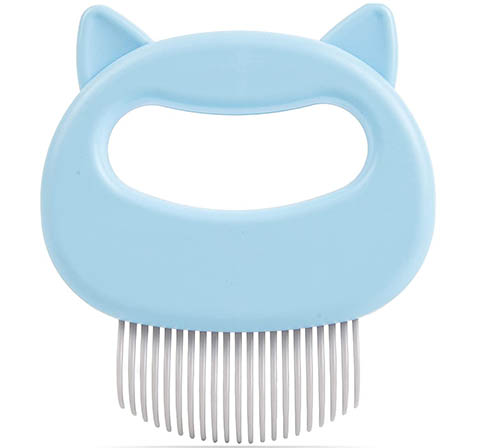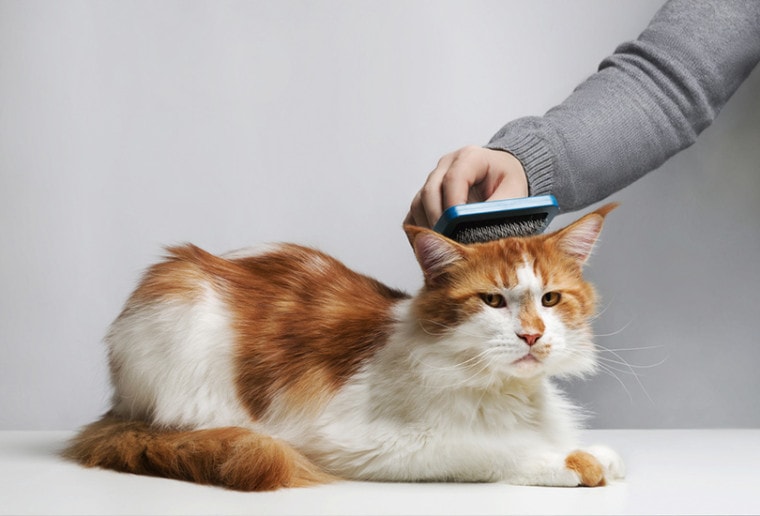
Cat parents know loose fur is a part of life, but you might not want it drifting all over your living room. In addition to curtailing the unpleasant aesthetic, you should brush your cat often to prevent matting, evenly distribute the natural oils in their coat, and remove dirt and dander. Just like humans, there’s a purrfect type of brush for every feline depending on their temperament and length and type of coat. Here are seven types of brushes, and the cats they suit best.
The 7 Types of Brushes for Every Cat
1. Slicker Brush
- Our Recommendation: Hepper Deshedding Cat Brush
| Materials: | Stainless steel, plastic |
| Best For: | Long-haired cats who like to be groomed |
A slicker brush is a classic choice for cats who easily get matted. Your cat might nudge the brush and purr, enjoying the gentle massage as you declutter its coat. Although you can use this brush on short-haired cats, it is definitely the best choice for long-haired cats with fur between 2-5” who love spa day.
If your cat really detests the idea of being groomed by a human, consider using a glove instead.
The stainless-steel bristles gently pull and catch loose fur, but the plastic coating on the ends of these circular needles protect your cat’s coat from damage. We like this brush because it has a self-clean button. Pop the button to eject the loose fur and dander at the end of your grooming session, and you’re ready for next time!
2. Bristle Brush
- Our Recommendation: Mars Coat-King Bristle Cat Hair Brush
| Materials: | Wood, boar’s hair |
| Best For: | Short-haired and curly-haired cats |
Use a soft bristle brush to smooth your curly-haired feline’s wiry coat and distribute the oils on their skin. Although any cat might enjoy the gentle rubbing sensation, it’s especially beneficial to short-haired cats with fur up to 2” long and curly-haired cats because it focuses on cleaning their skin instead of detangling long matted hair.
The only downside to this type of brush is that it’s a little harder to clean than a slicker or de-shedding tool. You’ll need to rake out the loose fur with a fine-toothed comb and wash the brush occasionally with dish soap and water.
3. Mitt Brush
Let this mitt brush give you a hand in grooming your kitten. If your cat scowls at a slicker brush, they might see if they’ll tolerate a mitt brush. After all, they’re getting rubbed while they’re being groomed, so they might not even notice you’re actually cleaning them. The best part about it for you, human, is that it catches the loose hair and all you have to do is hand-wash it with soap and water when you’re done “petting” your cat.
4. Self-Cleaning Slicker Brush
- Our Recommendation: Hertzko Self-Cleaning Slicker Brush
| Materials: | Plastic, metal |
| Best For: | Everybody |
We like this best-selling brush because it’s a self-cleaning type of slicker brush that comes in different sizes to fit every cat. The sensitive skin version has plastic-tipped needles, so they don’t unpleasantly scratch your cat’s coat. Some cat breeds, such as the Devon Rex, have quite thin skin, so they might benefit from this added protection. When it’s time to clean this slicker brush, all you have to do is press the button and the fur pops out as the bristles go in. It’s that simple!
5. FURminator
- Our Recommendation: FURminator deShedding Tool
| Materials: | Plastic, metal |
| Best For: | Cats who shed a lot |
The controversial FURminator is loved by people who own cats who shed a ton of hair but questioned by skeptics who disapprove of the “blades” in the design. Some users say it unnecessarily rips out more cat hair than it needs to, while others positively rave about how much less their cat sheds all over their house since they started using their FURminator. If you want to give it a try, the FURminator comes in two different sizes and two different models to suit every cat.
6. Flea Comb
Although no one wants to think of fleas, it’s important to keep a cheap flea comb in your grooming arsenal because these vicious pests carry lots of diseases and spread quickly. Not even the harshest chemical flea treatments may be able to prevent them all during the height of flea season because these pests are so resilient. To use your flea comb, part your cat’s fur against the grain and run the comb through their fur.
Flea combs work by trapping the fleas, but then you must dunk the comb in soapy water in order to kill the buggers. Since fleas can swim, you might be wondering why that works so well. It’s because soap breaks up the water’s surface tension, which makes the fleas drown.
7. Cat Comb for Massage
- Our Recommendation: Cat Comb for Massage
| Materials: | ABS plastic |
| Best For: | Cats who love to be pampered |
Perhaps your cat wants a comb instead of a brush so that they can get a soft massage out of their grooming sessions. While this tool won’t necessarily de-shed your long-haired cat, it will remove some fur and may train them to appreciate grooming time so that you can warm them up to more effective tools eventually.
Conclusion
Whether your cat loves to be groomed or hides in fear and dread at the sight of the brush, we’ve compiled a list of the best types of cat brushes for every cat. Brushing is a vital part of maintaining your cat’s coat (and home). It should be done weekly for short-haired cats, or even daily for long-haired cats, especially during the height of shedding seasons in the spring and fall.
Featured Image Credit: Sergey Fatin, Shutterstock
